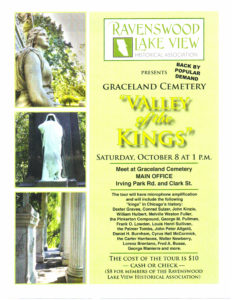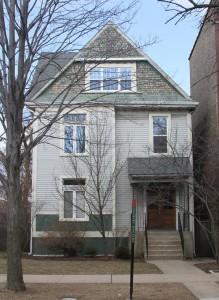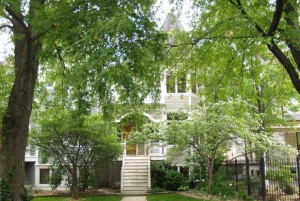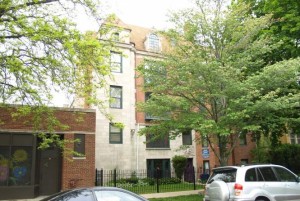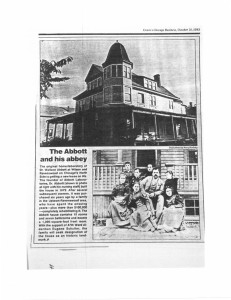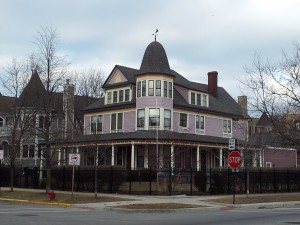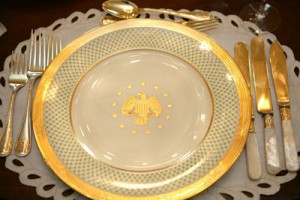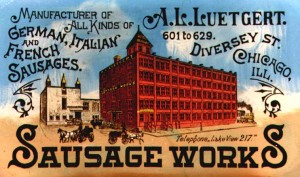Tours
Walking tours
This is a self-guided tour of the Ravenswood neighborhood. The tour starts at the Metra Stop for Ravenswood and proceeds south along Commercial Avenue (now Hermitage). The people who lived along the route, the architecture and the history of the area will be discussed.
The tour is under two miles and is flat.
Do not park on Ravenswood north of Lawrence as the parking there is private. There is public parking on Ravenswood south of Lawrence both east and west of the Metra railroad. There is also metered parking on Lawrence.
Most side streets in this area are not zoned, meaning you can park on most side streets.
There are numerous restaurants available for relief and refreshment. They are located on Ravenswood, Lawrence, Irving Park and Montrose. A small play lot is available near the end of the tour. In summer the play lot will have a working water fountain.
Near the end of the tour is a large city park with rest rooms and working water fountains.
The tour will use geo-location from your cellular device in the future. It is currently available off-line.
For your convenience, the tour is published below.
- A Walking Tour of Old Ravenswood
- The Illiniwek
- Abbott Labs
- Home of Carl Sandburg
- Fitzgerald Houses
- Jenson Building
- Abbott Mansion
- Wilson Avenue
- All Saints Episcopal Church
- Galloway House
- Ravenswood YMCA
- 19th Century Rentals
- Andrews House
- Ravenswood United Methodist Church
- Sinclair House (Hudson House)
- Kirkham House
- 1st Congregational Church/ Library Hall
- Cole House
- Ravenswood Presbyterian Church
- Helen Zatterberg Playlot Park
- Emanuel House
- Hamlin House
- Linthicum House
- Progress Building (Deagan Building)
- Friends of Rod Blagojevich
- Capt. Knight House
- Bethany United Church of Christ
- Ackley House
- Pettit House
- Ravenswood Elementary School
- Sulzer Family
- Paul-Mont Apartments
- Washburn House
- Thisslew Apartments
- Philadelphia Romanian Church (Ravenswood Church of Christ Scientist)
- Bennett Apartments
- American Indian Center (Masonic Temple)
- Truc Lam Temple (Ravenswood Club)
- Our Lady of Lourdes Church
- Chase Park (Gunther Park)
4800 North Ravenswood Avenue
Early Human Settlement
The State of Illinois is an outgrowth of the history of many peoples. Many of their influences have vanished, sealed beneath the foundation of homes and the construction of roads. Here, in Ravenswood, Native Americans lived for thousands of years prior to the first European explorers.
Pause a moment here, on the train platform and have a look around. In your mind’s eye, can you remove the buildings and roads to imagine what this place was like 500 years ago?
This area lies about a mile from Lake Michigan and about a mile from the Chicago River. Prior to European settlement the area was a mix of marsh and low sandy ridges, one of which formed the Green Bay Trail.
Today we call the Green Bay Trail by a different name: Clark Street.
Mound people, called Mississippians, probably established a settlement about six miles from here in Chicago near Wolf Point. The collapse of the Mississippian culture coincided with the ravages due to the introduction of Euro-Asian diseases, the beginning of the Little Ice Age and the introduction of horses to North America.
We are not aware of any Mississippian culture locations in the Ravenswood area.1 2
Sometime around the collapse of the Mississipian culture in 1500 C.E. the Neshnabek tribe migrated from what is now Western Ontario to an area on the eastern shore of Lake Michigan. In 1634 Jean Nicolet, a French explorer, met members of the tribe at Red Bank, Door County, Wisconsin. It is during this encounter that the Neshnabek tribe first became known as the Pouutouatami.3
The rage of the Iroquois forced Eastern tribes to flee into the the Midwest. Attacks by the Iroquois in the Ontario Peninsula against the Potawatomi, Sac, Fox, Kickapoo and the Miami temporarily ended European exploration of the Midwest. As a result of the Iroquois attacks, the Potawatomi relocated across Lake Michigan to Green Bay and Door County in Wisconsin.4 By 1667 the French and Iroquois had agreed on peace terms allowing French coureurs de boid to search further into the Midwest for fur.5
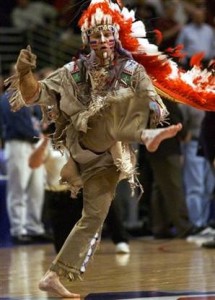
Chief Illiniwek, a modern interpretation of the tribe that once lived in the Chicago area, was once the mascot of the University of Illinois. The school was criticized for what many people, including Native Americans, considered a racist depiction of the Illiniwek tribe.
The native people around the tip of Lake Michigan called themselves the Illiniwek. Their tribe gave their name to the state through the French: Illinois.6
Their tribe spoke a language shared by many other tribes, Algonkian. Those tribes included the Cahokia, the Kaskaskia, the Michigamea, Moingwena, Peoria, Miami and Tamaroa.
Despite their shared language, the Miami were considered a separate tribe from the Algonquin confederacy.
French influence in the area increased with a key moment being the first European use of the Chicago portage by Rene’ Robert Cavelier de LaSalle in 1670.7 In 1671, in a ceremony held at Sault Saint Marie, the French laid claim to the lands of the Illinois.8
The population of the Illiniwek were estimated to be about 6,500 by Father Louis Hennepin, OFM, a French missionary about the year 1680. de La Salle, in 1684, states about 1,200 Illinois warriors gathered at Fort St. Louis in that year.
The Illiniwek and the other tribes encountered by the French, were not settled people. Some of the older members of the tribe, along with slaves, would plant fields of maize, gourds and pumpkins. These fields would be left for growing as the tribe engaged in hunting elsewhere.
Winter quarters may have consisted of long arbors covered with mats of reeds.
The Illinois Confederation of tribes could not resist the Iroquois invasion of the Midwest. Many of the tribes crossed the Mississippi River to settle in Kansas, Missouri and other western states.
In the years that followed the area around the mouth of the Chicago River changed hands several times. The Miami, the Potawatomi, a French garrison, the Potawatomi and the Chippewa, the French again and finally the British, who took control of the area in 1763.
The Potawatomi remained a force in the area, allying against the US and with the British, even after the Treaty of Paris gave the US sovereignty of the area. In 1812 a Potawatomi band ambushed the garrison of Fort Dearborn as it attempted to march to Fort Wayne.
The total defeat of the US forces temporarily ended US administration of the Chicago region. US forces militarily defeated the Potawatomi, being led by Tecumseh, at Moraviantown, Ontario in 1813.9
The US rebuilt the destroyed Fort Dearborn in 1816. You can see its outline today at the corner of East Wacker Drive and North Michigan Ave.
The US defeat at Fort Dearborn had unfortunate long-run consequences for Native tribes. Remembering the ‘massacre’, European settlers demanded the removal of all native tribes from the new state of Illinois.
In 1832 the last major Native American effort in Illinois ended in disaster as the local militia, regular US Army units and Sioux nearly exterminated Chief Black Hawks followers of Sac and Fox at Bad Axe in Wisconsin.10
A treaty signed in Chicago in 1835 (the Chicago Treaty of 1833) caused the evacuation of the Potawatomi from Illinois. According to Ron Grossman, writing for the Chicago Tribune, 500 warriors gathered in Chicago to conclude the treaty, dancing in full dress and brandishing tomahawks.
It was the last recorded war dance in the Chicago area.11
Continue Reading
4753 North Ravenswood Avenue
You’re looking at 4753 N Ravenswood. A building here was once owned by Abbott Labs. The company, which is reported to have about 90,000 employees and $35 billion in revenues, was once located on this strip of light industrial buildings.
The company was founded in 1888 by a drug store owner and physician name Dr. Wallace C Abbott.
Abbott used plant alkoloids such as morphine, quinine, strychnine and codeine, in tiny pills that allowed for more consistent and effective dosing.
Today Abbott Labs is known for producing the first HIV blood screening test, Ensure and many other drugs, treatments and products.
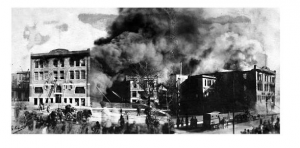
The 1905 Abbott fire threatened neighbors tired of fires and fumes from Abbott Labs. Credit: Ravenswood Lake View Historical Association Collection
But it wasn’t a very good neighbor.
Fumes from the labs, located here, often caused workers to have to be sent home ill. And the chemicals, beside causing unpleasant smells, sometimes burst into flames, threatening the wooden homes located on the quiet streets behind the plant.
For example on November 9, 1905 a fire in a printing plant owned by Abbott Labs threatened the neighborhood. According to fire officials a shift in the wind could easily have engulfed the pharmaceuticals lab and its chemicals.
Abbott Labs lost $200,000 in the fire. In 1925 the company departed Chicago for the suburbs.
WALKING DIRECTIONS TO NEXT STOP ON TOUR
Continue the tour to 4646 North Hermitage Avenue.
- Walk south about 486′ to the first cross street, Leland Avenue.
- Turn left. Proceed to the next street, Hermitage, a distance of about 427′. You’ll cross a service way called an alley.
- At Hermitage Street, turn right. The next building will be on your right in about 157′.
- Click the ‘Continue the Tour’ button below when you’ve reached your destination.
MAP OF DIRECTIONS TO NEXT LOCATION
4646 North Hermitage Avenue
The modest house you are looking at was an early home of the poet Carl Sandburg.
Sandburg moved to Chicago in 1912, living in a second floor apartment in this building. He was a reporter for the Chicago Daily News and a member of All Saints Episcopal Church. Here he composed among the best known of his poems, Chicago, published in 1915.
He lived here with his wife Lillian and his daughter Margaret, then two years old.
On locating the apartment Sandburg wrote Lillian he had found “our really, truly home.”
The Sandburgs moved to Maywood in 1914.
The building itself has been ‘marred,’ according to a 1994 writer, by poor choices in window replacement, aluminum siding and the removal of the front porch.
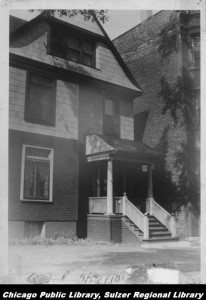
This undated photo from the Sulzer Library’s Ravenswood Lake View Historical collection shows the Sandburg home some years ago.
It was built between 1891 and 1894.
Listen to Roy Trumbull read the poem Chicago
Chicago
Hog Butcher for the World,
Tool Maker, Stacker of Wheat,
Player with Railroads and the Nation’s Freight Handler;
Stormy, husky, brawling,
City of the Big Shoulders:
They tell me you are wicked and I believe them, for I have seen your painted women under the gas lamps luring the farm boys.
And they tell me you are crooked and I answer: Yes, it is true I have seen the gunman kill and go free to kill again.
And they tell me you are brutal and my reply is: On the faces of women and children I have seen the marks of wanton hunger.
And having answered so I turn once more to those who sneer at this my city, and I give them back the sneer and say to them:
Come and show me another city with lifted head singing so proud to be alive and coarse and strong and cunning.
Flinging magnetic curses amid the toil of piling job on job, here is a tall bold slugger set vivid against the little soft cities;
Fierce as a dog with tongue lapping for action, cunning as a savage pitted against the wilderness,
Bareheaded,
Shoveling,
Wrecking,
Planning,
Building, breaking, rebuilding,
Under the smoke, dust all over his mouth, laughing with white teeth,
Under the terrible burden of destiny laughing as a young man laughs,
Laughing even as an ignorant fighter laughs who has never lost a battle,
Bragging and laughing that under his wrist is the pulse, and under his ribs the heart of the people, Laughing!
Laughing the stormy, husky, brawling laughter of Youth, half-naked, sweating, proud to be Hog Butcher, Tool Maker, Stacker of Wheat, Player with Railroads and Freight Handler to the Nation.
 
WALKING DIRECTIONS TO NEXT LOCATION
Continue the tour to 4611 North Hermitage Avenue.
- Continue south along Hermitage for about 364′. The building will be on your left, across the street and before the next corner.
- Click the ‘Continue the Tour’ button below when you’ve reached your destination.
4611-4613 North Hermitage
These houses were built in 1990 by architect Patrick Fitzgerald. He designed the houses with sensitivity to the surrounding neighborhood, and to the other structures immediately around the two new buildings.
WALKING DIRECTIONS TO NEXT LOCATION
Continue the tour to 4604 North Hermitage Avenue.
- The next building is across the street, about 33′ from you.
- Click the ‘Continue the Tour’ button below when you’ve reached your destination.
4606 North Hermitage Avenue
Fanciful quarter–turret, bay parapet, console, round–arched dormer surround, balcony grilles, weathervane, shaped brick chimney and carved stone door surround. Highly picturesque.
HISTORICAL FEATURES
Jens Jensen, a building architect with the same name as the more famous landscape architect, specialized in apartment buildings. He built a number of them in the 1920’s.
WALKING DIRECTIONS TO NEXT LOCATION
Continue the tour to the mansion across Hermitage, 4605 North Hermitage.
- The next building is across the street, about 25′ from you.
- Click the ‘Continue the Tour’ button below when you’ve reached your destination.
4605 North Hermitage Avenue
Masterful use corner site, including corner turret, wraparound porch and porte cochere, make this Queen Anne house look much larger than it really is. Note on the alley the matching coach house which still has original stable doors and central tower, increasing its apparent size. Beautiful art nouveau stained-glass window on west side of second story. Additions of north dormer, modern window sashes, rear balcony, and ornament.
HISTORICAL FEATURES
This corner lot was used by the community for Independence Day picnics from 1875. However, in 1888 it was purchased by Dr. Wallace Abbott, a local doctor and pharmacist. He commissioned Rudolph Dahlgren and Oscar Livendahl to design the current home. It was completed in 1891.
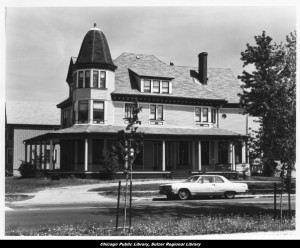
The Abbott Mansion during the years it struggled. Credit: Ravenswood Lake View collection, Sulzer Library
Dr. Abbott had gotten his start in his pharmacy and medical office, located on Ravenswood Avenue, manufacturing the first medications in his kitchen apartment. The company he founded, Abbott Labs, moved with the family to this location in 1891, then the company moved to the first of several properties on Ravenswood.
The company sites were known for several spectacular fires as well as industrial accidents leading it to move in 1925 to rural North Chicago.
Dr. Abbott could boast of owning an early telephone, among the first on the North Side. It’s simple number was Lake View 143.
The 1900 Census notes Dr. Abbott, his wife Clara, their daughter, Dr. Abbott’s father, a cook a nurse girl and a stableman.
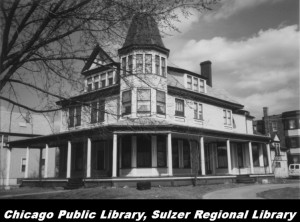
The Abbott Mansion during the years it struggled. Credit: Ravenswood Lake View collection, Sulzer Library
Dr. Abbott died on his way home from the office one day in July 1921.
The Abbotts moved in 1925, selling the building to the Maginot family. They used the building as the Maginot Funeral Home for many years.
A 1983 story in Crain’s Chicago Business notes the then owners, not the Maginot’s, had purchased the mansion after it had gone through several owners. They had, the story notes, spent six years and $100,000 to attempt to restore the building.
“The Abbott House contains 15 rooms and seven bathrooms and boasts a 1,300 square foot front room,” the story notes.
A Chicago Magazine story has more information, noting the Maginot family had sold the property in the 1970’s. In 2004 Abbott Labs took possession of the property for $1.5 million.
Abbott Labs cloned the property, according to Chicago Magazine, removing the front door, a fireplace mantel, some stained glass and a stepping stone engraved with the name Wallace Abbott.
The second Abbott mansion exists on the company’s campus in North Chicago.
After being awarded a Chicago Landmark Award for Preservation Excellence by the Commission on Chicago Landmarks in 2006, the home was sold by Abbott Labs for $1.95 million.
The home was last sold in 2011 for $1,606,000.
WALKING DIRECTIONS TO NEXT LOCATION
Continue the tour to the corner of North Hermitage Avenue and West Wilson Avenue.
- The next location is about 33′ from you.
- Click the ‘Continue the Tour’ button below when you’ve reached your destination.
Wilson & Commercial Avenues
Before it was called Hermitage, this street was named Commercial Avenue. With the Abbott Mansion on your left shoulder, gaze first across Wilson Avenue.
New buildings can be seen for some distance down Hermitage. The Ravenswood YMCA once stood here. It was built in 1905. By the late 1970’s the building was in need of financially significant work to bring it up to the standards of the day.
As a result the YMCA was demolished. Developers later purchased the land. We’ll get to that in a moment.
Across the street is the All Saints Episcopal Church. Built in 1883, the church is believed to be the oldest frame church remaining in the city. We’ll get to that in a moment too.
Continue to turn to the right. A restaurant/ bar called O’Shaughnessy’s currently occupies the Pickard Building, located at 4557 N Ravenswood.
Pickard China
Pickard China used the building to house artists on the second floor. They painted imported white china.
First established in Edgerton, Wisconsin, the company was moved to Chicago by its founder Wilder Pickard. Artists from Europe and the Art Institute of Chicago decorated the one of a kind ceramic pieces, now highly prized by collectors.
In the 1920’s the company developed a line of fine china dinnerware. The company moved to Antioch, Illinois in 1930.
The line of china used by the US Department of State for dinners in our embassies and missions is manufactured by Pickard. Perhaps you’ve been invited to dinner at an embassy and seen this local company’s product appear below your plate?
Albert “The Sausage King” Luetgert
Albert Luetgart was among the many entrepreneurs building an empire on the backs of hogs. The Foreman Brothers Bank, which was once located in the Pickard Building, was embarrassed to discover, in 1898, that it held Albert’s mortgage.
Albert had established a packing house and stockyard on the city’s North Side, in the 1700 block of West Diversey Avenue, in 1879. It had become very successful over the years, from an initial investment of four thousand dollars to a point where the A.L. Luetgert Sausage & Packing Co. was considered the ‘sausage king’ in the 1890’s.
On May 1, 1897 Mrs. Luetgert, Louisa, disappeared.
Albert told his children their mother was visiting her sister. After a few days, Diedrich Bichnese, Louisa’s brother, reporter her missing to the police.
Luetgert now said Louisa had run away with another man.
A police investigation demonstrated a history of domestic violence and financial difficulties. Albert, it turned out, was seeing a wealthy widow. He planned to marry her once he got rid of Louisa.
Further police inquiries discovered that Louisa was seen on the evening of May 1 entering the factory with Albert at about 10:30 p.m.. The police discovered that Albert had sent the night watchman home early that night, though the man confirmed he had seen Louisa enter the plant. And the police discovered Albert had purchased arsenic and potash the day before. Those chemicals were not common in the manufacture of food products.
A search of the factory found suspicious sausage and human residue in an oven. Two of Louisa’s rings and human remains were found. Albert was arrested and tried for the murder.
Albert claimed there were numerous reports of Louisa being seen around the US, casting enough doubt that the jury was unable to reach a verdict in 1897.
A second trial was held in 1898. This time the prosecution used George Amos Dorsey, an anthropologist at the Field Museum, to prove to the jury that the bones were human. Protesting his innocence, Albert was sent to prison. He died there in July 1899.
The trial was a media circus, widely reported and leading to media excesses. It was among the first cases that depended on a forensic expert to resolve the crime.
Zephyr Cafe & Ice Cream
Byron Kouris was among the many Greek- Americans who entered the restaurant business. In the 1960’s he started a chain called the Lunch Pail. He started Byron’s Hot Dogs with locations in Ravenswood (1701 W Lawrence Avenue), Wrigleyville (1017 W Irving Park Road), the Near West Side (680 N Halsted Street) and Lincoln Park (850 W North Avenue).
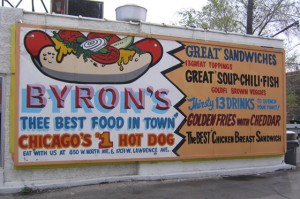
A restaurant called the Zephyr once operated in the Pickard Building. It was owned by Byron Kouris, better known as the owner of Byron’s Hot Dogs. Credit: Shy Full of Bacon
In 1976 he started Zephyr in the Pickard Building. For 30 years, ending in 2006, the Zephyr was known for its huge ice cream dishes.
Byron’s was inducted into the Vienna Beef Hot Dog Hall of Fame. In 2010 a replica Byrons served hot dogs on the lawn of the White House for the 2010 Congressional Picnic.
Byron closed the Zephyr, to the sorrow of many neighborhood children with eyes larger than their stomachs. He died in March 2006 at age 76.
Here’s a question for you: why is this group of commercial buildings on Wilson Avenue HERE? In most cases, these intersections have small commercial strips facing Ravenswood Avenue. The Wilson Avenue strip extends for a block west past Ravenswood.
The answer lies about an eighth of a mile west where you may see a Chicago Transit Authority train running on the Brown Line elevated platform. Until the early 1950’s the Brown Line, then known as the Ravenswood Line, had a stop here at Wilson Avenue. In addition, the Chicago & Northwestern Railroad had a depot here serving Ravenswood.
The Brown Line was built into the neighborhood with the Western Avenue station opening in May 1907. A real estate boom followed. The ‘L’ allowed inexpensive and fast service from the area to the city center.
WALKING DIRECTIONS TO NEXT LOCATION
Continue the tour to All Saints Episcopal Church, 4550 North Hermitage Avenue.
- Cross the street to All Saints Episcopal Church
- Click the ‘Continue the Tour’ button below when you’ve reached your destination.

